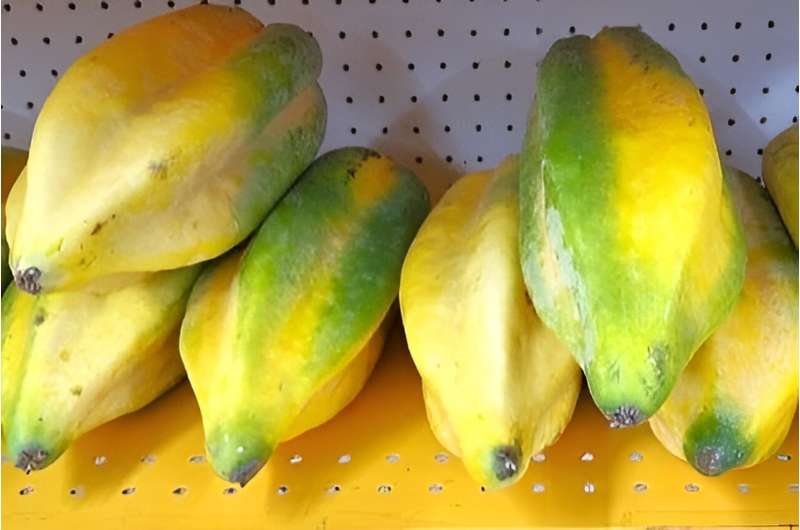This article has been reviewed according to Science X's editorial process and policies. Editors have highlighted the following attributes while ensuring the content's credibility:
fact-checked
proofread
New method pinpoints virus that targets Ecuador fruit crop

Scientists in Ecuador have developed a new method to detect and diagnose a virus that devastates crops of babaco, a fruit plant of economic importance to local farmers.
The team, at Universidad San Francisco de Quito in Ecuador, developed species- and genus-specific primers to detect the Babaco Mosaic Virus (BabMV) and its closest relatives by RT-PCR and RT-qPCR.
The research is outlined in an article, "Development of novel species-specific and genus-specific primers for the detection of Babaco Mosaic Virus (BabMV)", which appears in Letters in Applied Microbiology.
The novel primers will contribute to an accurate detection of this virus and a better management of the babaco crop in Ecuador, says corresponding author Dr. María de Lourdes Torres.
Hybrid cultivar
Babaco (Vasconcellea heilbornii var. Pentagona Badillo) is a sterile, hybrid cultivar of the Caricaceae family resulting from the interspecies cross between Carica pubescens (chamburo) and Carica stipulata (toronche). It is native to the subtropical regions of Ecuador and Colombia, she said.
"Its fruit has a high nutritional content and delicate acid flavor and aroma, making it attractive for international commercialization. Babaco production is one of the main sources of income for hundreds of families in the Ecuadorian highlands," Dr. Torres said.
"Babaco plants are affected by several phytopathogens that cause significant crop losses. Viruses are of special concern since they not only reduce crop yield and damage fruits but also reduce the life span of the plants. This issue raises great concern among babaco growers.
"The threat posed by viruses, especially Babaco Mosaic Virus (BabMV), to babaco crop production makes it necessary to develop efficient detection and diagnosis techniques in order to promote this crop production and enhance the economy of local farmers in Ecuador."
Novel species-specific primers
The team developed novel species-specific primers to detect BabMV targeting a 165 bp region of the coat protein (CP). Genus-specific primers were designed to validate the species-specific primers and attest their ability to discriminate between BabMV and its closest relatives. These primers targeted a 175 bp fragment of the CP region.
The most effective sets of primers were chosen for reverse transcription polymerase chain reaction (RT-PCR) and SYBR Green-based quantitative reverse transcription polymerase chain reaction (RT-qPCR) in symptomatic and asymptomatic babaco plants.
Among 28 plants tested, 25 were positive and three were negative for BabMV using species-specific and genus-specific primers in RT-PCR and RT-qPCR, while the PapMV positive control used was detected with the genus-specific primers and was negative for the species-specific primers.
In this way, the scientists standardized a protocol that could be used to detect BabMV and its closest relatives in babaco crops and contribute to a more efficient production of this fruit in Ecuador.
Scale of virus threat
What proved surprising was the scale of the threat posed by the virus.
"Babaco Mosaic Virus (BabMV) appears to be a highly prevalent phytopathogen in babaco plants, even those grown under greenhouse conditions. Our study, which focused on nursery babaco plants, highlights the widespread nature and significant concern of this virus in Ecuador," Dr. Torres said.
"The presence of BabMV impacts both food security and the economic sustainability of many local farmers in Ecuador.
"The results of our research shed light on a methodology that could also be developed for other plant pathogens that affect economically important crops throughout the region. Efficient detection and diagnosis methods are the first step in controlling diseases that reduce crop production and yield.
"In this way, the primers developed in this study will help to identify affected crops in the country and start developing strategies to manage the diseases caused by BabMV and its closest relatives."
Larger sample size
Future studies will require a more diverse sample size to strengthen and validate the robustness of the primers, Dr. Torres said.
"Our study was limited to nursery babaco plants from three different localities in Ecuador, serving as a preliminary test of our primers on an accessible and affordable group of plants at the time. Subsequent studies should include a larger sample size from various locations to further validate our results. Additionally, future research should include plants growing in the field, not just in nurseries, to gain a broader understanding of our primers' validity."
The study was led by four Ecuadorian women scientists from Universidad San Francisco de Quito (USFQ) from the Plant Biotechnology Laboratory.
More information: Martina Albuja-Quintana et al, Development of novel species-specific and genus-specific primers for the detection of Babaco Mosaic Virus (BabMV), Letters in Applied Microbiology (2024). DOI: 10.1093/lambio/ovae070
Provided by Applied Microbiology International





















